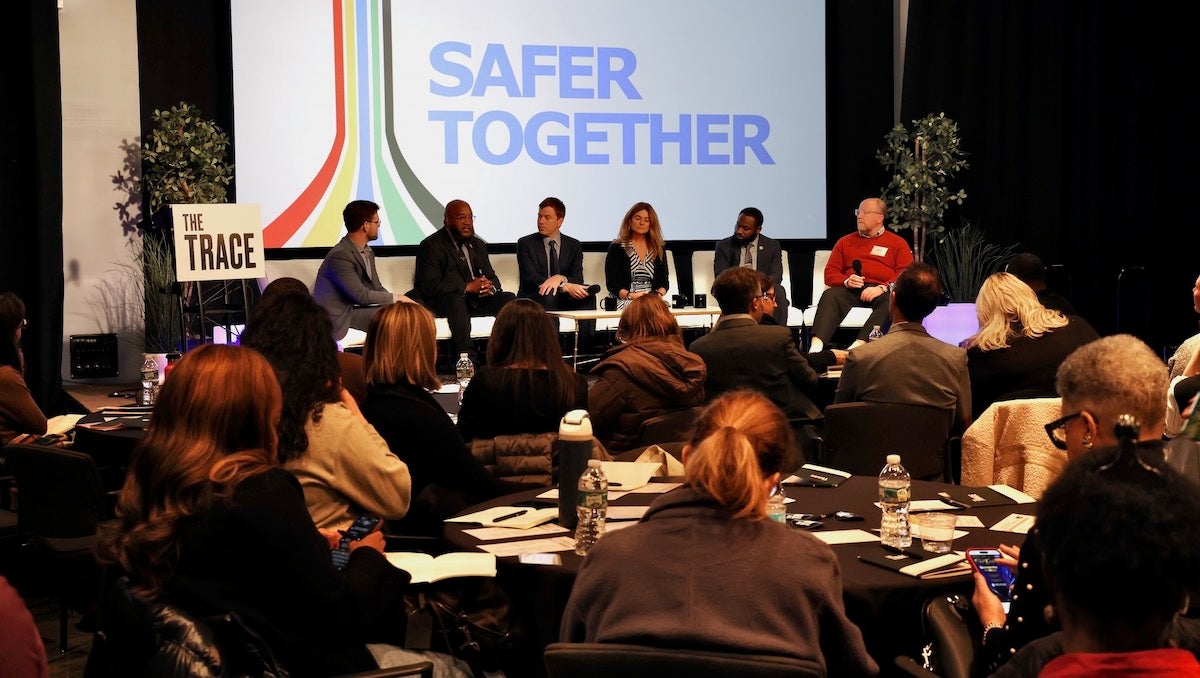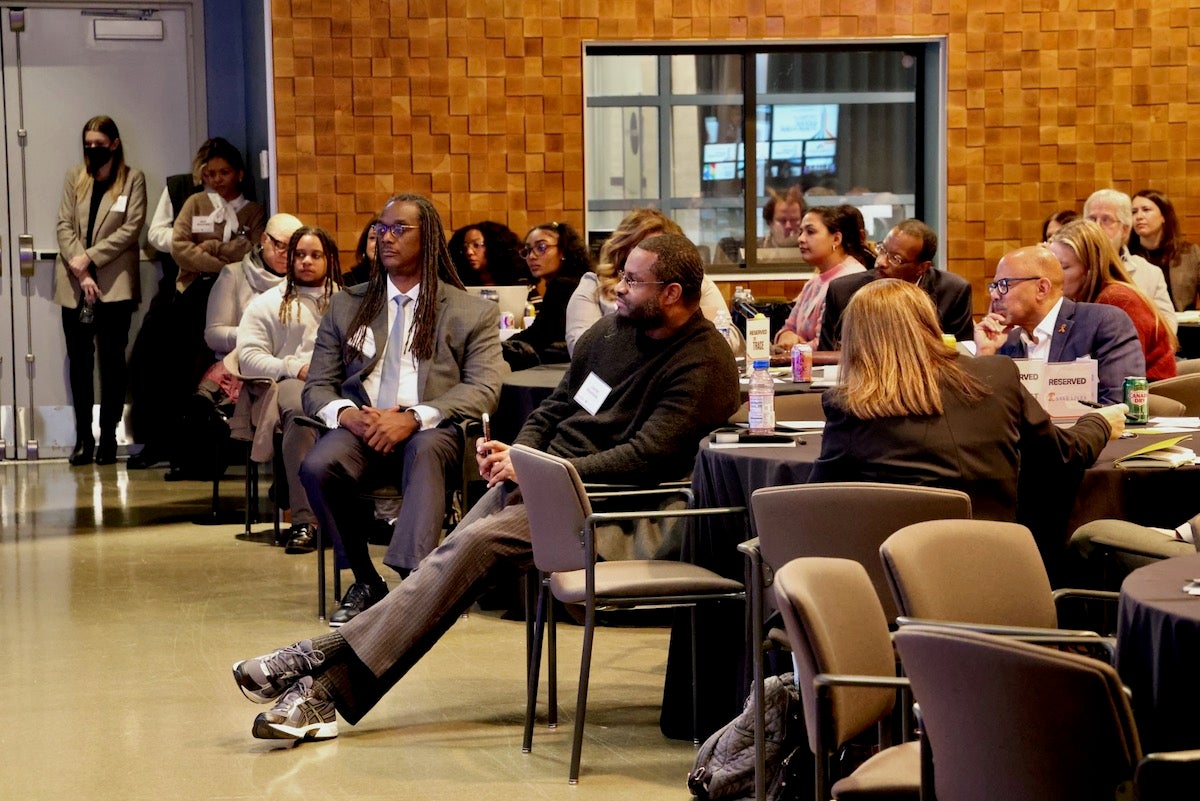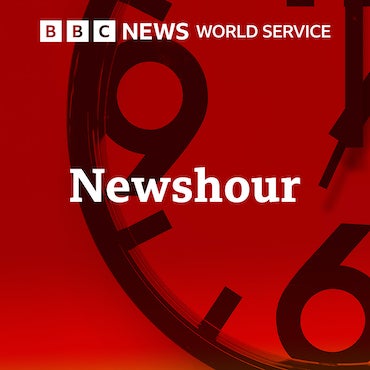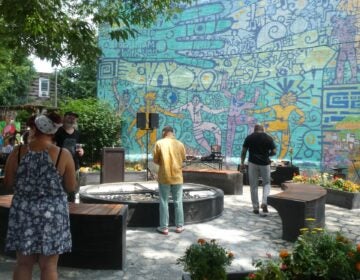Philadelphia has achieved ‘unprecedented’ reduction in gun violence. Experts gathered to discuss how
Lt. Gov. Austin Davis told the gathering that the administration still considers combatting gun violence a top issue.
Listen 1:18
Pennsylvania Lt. Gov. Austin Davis (left) talks about his focus on gun violence prevention with journalist Mensah Dean of The Trace during that publication's violence prevention forum, ''Safer Together,'' at WHYY. (Emma Lee/WHYY)
From Philly and the Pa. suburbs to South Jersey and Delaware, what would you like WHYY News to cover? Let us know!
An inaugural forum put on by nonprofit newsroom The Trace, hosted at WHYY’s Philadelphia studios, convened civic leaders, researchers, local practitioners and youth voices to spotlight what’s working — and what still needs doing — to reduce gun violence in American cities.
The event, titled “Safer Together: A Forum on Gun Violence Solutions,” brought together national experts, community stakeholders and policy leaders for a five-panel program followed by a networking reception.
Philadelphia — a city that recently recorded its lowest homicide rate in more than five decades — was chosen as the forum site in part because it illustrates how progress is possible in even deeply challenged urban environments.
“Last year, no other major city reduced gun violence more per capita than Philadelphia, making the case for just how much progress is possible, but too few people know about these gains today,” said Jennifer Mascia, senior news writer at The Trace. “We’re changing that over the course of this event.”

‘No. 1 issue’
Pennsylvania Lt. Gov. Austin Davis joined the conversation as the keynote speaker and was interviewed by The Trace’s Philadelphia correspondent Mensah M. Dean. Davis told the gathering that an early incidence of gun violence molded his political life.
“Gun violence is the very issue that brought me to public service when I was 16 years old,” he said, recalling the shooting outside his childhood home that pushed him to launch a youth-led violence prevention group in McKeesport near Pittsburgh.
He went on to help Allegheny County create its first Office of Gun Violence Prevention, established Pennsylvania’s Violence Intervention and Prevention grant program as a state representative, and, now as lieutenant governor, chairs the Pennsylvania Commission on Crime and Delinquency.
He said the Shapiro administration has made public safety its core promise, because “really everything else we do doesn’t matter if we’re not meeting that basic need.” Asked where combating gun violence sits on his daily priority list, Davis said it is “the No. 1 issue that I have worked on and that I continue to work on.”
Davis called “federal instability” a recent challenge to prevention efforts, but said that the state has been working to make up for that loss. He highlighted the recent bipartisan budget that delivered a 10% increase in state prevention dollars and the administration’s decision to fully fund the state’s Office of Gun Violence Prevention for the first time.
Davis credited the drop in shootings in Philadelphia and other Pennsylvania cities to a comprehensive approach that mixes community-based work, law enforcement support and economic opportunity. He argued that reducing violence requires confronting root causes directly.
“The best way to take a gun out of somebody’s hand is to put a paycheck in,” he said, calling for expanded education pathways, apprenticeships and small-business support so that young people “have multiple opportunities to succeed.”
However, he explained that the issue is not isolated to Philadelphia or the region.
“Gun violence is uniquely an American problem, and it’s a problem that we can and must do something about,” he said.
He noted, however, that the issue manifests itself differently in different places.
“In rural Pennsylvania, it’s suicides … Domestic violence is another huge topic that often doesn’t get talked about. This is a concern I think that really cuts along racial lines in many ways. The concern is just slightly different depending on where you’re at,” Davis said.
Philly now and in the future
The Trace’s stated goal of the conference was to go beyond reporting the declines, and instead dig into strategy: what’s sustaining change, what new frontiers are emerging and what could tip backward if the politics or funding shift.
The opening panel featured David Brown, executive director of the Civic Coalition to Save Lives, and Adam Geer, Philadelphia’s chief public safety director. Moderator James Burnett, The Trace’s managing director, asked how can the city’s efforts lock in the progress that has led to the decline in gun homicides and avoid reversal?
“What’s different about what’s been happening the past three years?” Burnett asked. “What’s the ingredient that has led to the better outcome?”

Brown said the shift began when key players stopped working in silos and started acting like a true team, crediting the city with creating the Office of Public Safety.
“What feels different is the fact that we’re working together, there’s coordination, there’s a recognition that no one organization can do it,” he said. “Good ideas don’t care where they come from.”
Geer agreed that coordination is now taking place across city agencies, community groups and law enforcement in a way he called “unprecedented.” Asked about “what took so long” for the city to prioritize gun violence, which hit record highs even before the COVID-19 pandemic, Geer said they didn’t have the required continued investment they needed.
“We have to invest in this stuff,” he said. “That is why it’s so important for us to continue to communicate why this work is so important so that we can continue to be able to fund and expand these measures.”
Brown added that investment was helpful but that the overall strategy was equally important in their accomplishments.
“Knowledge is power and knowing what you don’t know is wisdom, so knowing what you don’t know is a very important factor to try to determine what would make the most sense,” he said. “The coalition did its homework, did some research, tried to get evidence-based strategies from around the country to say what might work here and stick to that.”
Both panelists agreed that there is still a lot of work to do — “One murder’s one too many,” Geer said — but that they could appreciate how far the city had come.
“That’s one less email that I wake up in the morning to,” he said of reduced homicide alerts, adding that every avoided shooting “is saving lives that are attached to families, that are attached to communities.”
Community violence intervention strategy
The second panel, moderated by Trace reporter Chip Brownlee, brought together five leaders working across research, outreach, policy and urban design. The panel included Chico Tillmon, of the Community Violence Intervention Leadership Academy, Matt Rader, of the Pennsylvania Horticultural Society, Temple University professor Caterina Roman, Philadelphia Deputy Director of Violence Prevention Initiatives Deion Sumpter and Ben Struhl, of the University of Pennsylvania’s Crime and Justice Lab.

Brownlee opened by noting a paradox: community-violence intervention has helped drive major declines in gun violence, yet the federal dollars that made much of that work possible are now drying up.
“What do you think the goal should be at this moment where there’s so much change?” he asked.
Tillmon touted the success of the “comprehensive ecological systems approach” where “everyone was involved,” but said that it may now be time to refocus how they promote the programs going beyond statistics.
“When you begin to humanize it and personalize it and say, ‘Because we’re doing particular work in these particular communities, there are human beings that are alive that otherwise would be dead,’ it resonates more than us just using numbers because numbers tend to make us equate it to ‘Is it worth the investment?’” he said.
Struhl cautioned that such successes are often doubted because many people “don’t believe that CVI [community violence intervention] saved those lives,” arguing the field must get more specific about what strategies are being used and why they work.
“And that’s why Philadelphia is down. A strategy exists that didn’t exist before and the people before were working really, really, really hard,” he said.
Other panelists stressed that evidence and community leadership must guide decisions going forward. Roman warned against treating programs as simple templates.
“Just because a program is reducing shootings … doesn’t mean it doesn’t do harm,” she said, calling for deeper attention to youth well-being and the “relational opportunities” that make interventions stick.
“It’s really time that we be thinking outside of these whims and the challenges that we have. How do we think about youth and adult well-being?” she said.
Sumpter described how Philadelphia’s ecosystem has grown into 173 funded organizations and said the culture in the city has shifted.
“The pulse … in the city is different,” he said. “In the past, individuals who were involved in violence prevention works were the individuals who were deeply impacted by gun violence. But today you have so many different institutions — hospitals, universities, nonprofit organizations — all wanting to be a part of the same fight because we now understand what works.”
However, Rader, whose work focuses on cleaning and greening blocks, said cities shouldn’t take gains for granted.
“There’s often a tendency in government and philanthropy to think there’s one giant solution that we can implement and the problem is eradicated and many problems require just continuing to do the evidence-based things that we know lead to good outcomes,” he said. But “this is a moment where that risk of forgetting that those gains came from somewhere and required continued spending matters.”
Overall, the panel agreed that the strategies that helped drive violence down — credible-messenger outreach, coordinated case response, environmental improvements and research-driven targeting — require stability to continue and build on the city’s successes.
‘Fear’-driven
The fourth panel focused on youth living with gun violence and the adults working closest with them. Moderated by The Trace’s Joy Resmovits, it featured Joseph H. Budd Jr., of Men Who Care of Germantown, Maleka Young-Jackson, Imani Star’s director of volunteer services, and Imani Star youth counselors I’jazz Carter and Ma’isah Young. Resmovits asked them to explain why young people are still picking up guns, even as overall shootings fall.
Carter and Young spoke bluntly about the impact that gun violence has had on their youth and their community.
“Gun violence has taken people away from me through either jail or death,” Carter said, adding many in his community “have PTSD and just don’t know it.”
A 2019 study found that “youth firearm injury exposure is clearly linked to high rates of post-traumatic stress symptoms.”
Young described how that trauma becomes numbness.
“If I hear gunshots, I’m not phased,” she said, noting that it’s also prevalent on social media. “We could literally watch a video of somebody being shot down to the ground and just be like, ‘oh dang,’ and keep going about our day. She recalled working at a funeral home where they would get “a lot of gun violence cases” each week.

Much of the discussion revolved around the motivations that youth sometimes have in resorting to gun violence. Budd said fear played a significant role.
“They don’t even feel safe in their neighborhood,” Budd said. “They will get a gun and carry a gun to protect themselves because they don’t feel safe … we want to put positive things in front of them before they think about picking up a gun.”
Jackson agreed saying that she hears youth say “I had the gun because I was scared. I didn’t feel safe,” but added that many young men “lack confidence.”
“A lot of them have ego and pride issues that they don’t know how to deal with,” she said. “They wish they had things that they can’t have that everybody else has. So I have always kind of been looking for a way to make sure they feel confident. And teach them a little bit more about moderation.”

Get daily updates from WHYY News!
WHYY is your source for fact-based, in-depth journalism and information. As a nonprofit organization, we rely on financial support from readers like you. Please give today.








